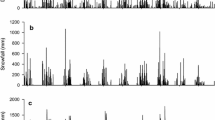Abstract
Aucuba japonica varieties are common evergreen understory shrubs in Japan. Aucuba japonica var. borealis is distributed on the Sea of Japan side of Honshu and Hokkaido where heavy snow cover lasts for more than 3 months in winter. Aucuba japonica var. japonica is distributed in areas with shallow or no snow on the Pacific Ocean side of Honshu and Shikoku. The ecophysiological characteristics of var. borealis were compared with those of var. japonica to examine the effects of heavy and long-term snow cover on the life cycle of var. borealis. Shoots of both varieties were shaded in crushed ice for 110 days, but their photosynthetic activities, chlorophyll contents and the chlorophyll a/b ratio was not affected. The leaves of var. borealis were no less frost tolerant than those of var. japonica. In spite of the difference in environmental factors, both varieties had similar characteristics in seasonal changes of photosynthesis, respiration and chlorophyll a/b ratio. These results suggest that var. japonica could survive in areas with heavy snow where it does not normally occur. Leaf net production (LNP) was estimated based on the microclimatic data and seasonal photosynthetic and respiration rates. The difference in the annual LNP between the two varieties was equivalent to the difference in the LNP during the snow season. One of the major effects of snow cover is to interrupt and reduce the production period of var. borealis.
Similar content being viewed by others
References
Arnon D. I. (1949) Copper enzymes in isolation chloroplasts. Polyphenoloxidase in Beta vulugalis. Plant Physiol. 24: 1–15.
Azumi Y. & Watanabe A. (1991) Evidence for a senescence-associated gene induced by darkness. Plant Physiol. 97: 577–83.
Billings W. D. & Bliss, L. C. (1959) An alpine snowbank environment and its effects on vegetation, plant development, and productivity. Ecology 40: 388–97.
Billings W. D., Godfrey P. J., Chabot, B. F. & Bourque D. P. (1971) Metabolic acclimation to temperature in arctic and alpine ecotypes of Oxyria digyna. Arc. Alp. Res. 3: 277–89.
Fukuoka N. (1966) On the distribution patterns of the so-called Japan Sea elements confined to the Sea of Japan region. J. Geobotany 15: 63–80 (in Japanese with English summary).
Gepstein S. (1988) Photosynthesis. In: Senescence and Aging in Plants (eds L. D. Nooden & A. C. Leopold) pp. 85–109, Academic Press, San Diego.
Hadley E. B. & Bliss L. C. (1964) Energy relationships of the alpine plants on Mt Washington, New Hampshire. Ecol. Monogr. 34: 339–57.
Hara, N. (1980) Shoot development of Aucuba japonica I. Morphological study. Bot Mag. Tokyo 93: 101–16.
Hotta M. (1974) History and Geography of Plants. Evolutionary Biology in Plants III. Sanseido, Tokyo (in Japanese).
Ishizawa S. (1978) Climatic factors affecting the distribution of Snow-Camellia (Camellia rusticana HONDA). In: Plant Ecology to the Memory of Dr. Kuniji Yoshioka (Soc. Tohoku Plant Ecol.) pp. 298–306. Sendai (in Japanese).
Karasawa T. (1984) The life and variation of genus Aucuba in Niigata prefecture. In: Distribution Maps of Vascular Plants in Niigata Prefecture (Japan) Vol. 5 (compiler Y. Ikegami, ed. S. Ishizawa) pp. 480–95. Jinenjo-kai, Niigata (in Japanese).
Kurosawa S. (1971) Cytotaxonomical studies on the genus Aucuba. J. Jpn. Bot. 46: 231–8.
Kurosawa S. (1976) Additional notes on cytotaxonomy of Aucuba japonica. J. Jpn. Bot. 51: 136–7 (in Japanese with English summary).
Maekawa F. (1949) Makinoesia and its bearing to Orient Asiatic flora. J. Jpn. Bot. 24: 91–6.
Melis A. (1990) Regulation of photosystem stoichiometry in oxygenic photosynthesis. Bot. Mag. Tokyo Special Issue 2: 9–28.
Murata G. (1971) Cornaceae. In: Colored Illustrations of Woody Plants of Japan, Vol. 1 (eds G. Murata & S. Kitamura) pp. 194–8. Hoikusha, Osaka (in Japanese).
Muramatsu I., Sato S., Umebayashi T. & Takeda T. (1990) Distribution of snow cover in Honshu with due consideration of satellite imagery. J. Jpn. Soc. Snow and Ice 52: 1–11 (in Japanese with English summary).
Ninomiya K. (1968) Heat and water budger over the Japan Sea and the Japan Island in winter season. J. Meteor. Soc. Jpn. 46: 343–72.
Pomeroy M. K., Pihakaski S. J. & Andrew C. J. (1983) Membranes properties of isolated winter wheat cells in relation to icing stress. Plant Physiol. 72: 535–9.
Richardson S. G. & Salisbury F. B. (1977) Plant responses to the light penetrating snow.Ecology 58: 1152–8.
Sakai A. (1982) Freezing resistance of ornamental trees and shrubs. J. Amer. Soc. Hort. Sci. 107: 572–81.
Sakai A. Hakoda N. (1979) Cold hardiness of the genus Camellia. J. Amer. Soc. Hort. Sci. 104: 53–7.
Sakai A. & Larcher W. (1987) Frost survival of plants. In: Ecological Studies, Vol. 62. Springer-Verlag, Berlin.
Suzuki H. (1962) The classification of Japanese climates. Tirigaku Hyouron 35: 205–11 (in Japanese with English summary).
Suzuki S. (1961) Ecology of the bambusaceous genera Sasa and Sasamorpha in the Kanto and Tohoku districts of Japan, with special reference to their geographical distribution. Ecol. Rev. 15: 131–47.
Takahashi K. (1960) Plants distribution and snow cover Jpn. J. For. Envir. (Shinrin Ricchi) 2: 19–24 (in Japanese)
Tukey J. W. (1977) Exploratory Data Analysis. Addison-Wesley Publishing, Massachusetts.
Uemura S., Takeda T. & Nakanishi N. (1986) Behaviours of the main temperate plants in Hokkaido along climatic gradients. Jpn. J. Ecol. 36: 141–52 (in Japanese with English summary).
Yamamura Y. (1986) Matter-economical roles of the evergreen foliage of Aucuba japonica, an understory shrub in the warm-temperature region in Japan. Bot. Mag. Tokyo 99: 323–32.
Yamazaki T. (1959) The plants distribution of Japan. Shizenkagaku to Hakubutsukan 26: 1–19 (in Japanese).
Author information
Authors and Affiliations
About this article
Cite this article
Kume, A., Ino, Y. Comparison of ecophysiological responses to heavy snow in two varieties of Aucuba japonica with different areas of distribution. Ecol. Res. 8, 111–121 (1993). https://doi.org/10.1007/BF02348523
Accepted:
Published:
Issue Date:
DOI: https://doi.org/10.1007/BF02348523




